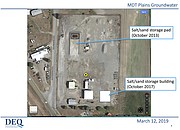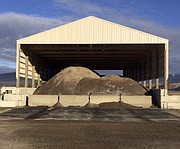DEQ presents update on salt in groundwater
How much headache can a simple pile of highway sand cause?
Plenty, if it’s laced with salt and that salt gets washed into the ground.
Montana Dept. of Environmental Quality (DEQ) Environmental Science Specialist Laura Alvey presented an update to Plains residents last week regarding an ongoing salty groundwater problem west of town.
In 2012, Montana Dept. of Transportation’s (MDT) Plains maintenance facility found salt in their well water. Further testing found the salt in neighboring residential wells in the shallow groundwater (20-50 feet below the surface). The source of the salt was identified as the pile of sand the snowplow trucks use to provide traction on slick winter roads. Salt (sodium chloride) is added to the sand to prevent it from freezing solid so it can be loaded in, and spread from, the trucks in cold weather. The pile had been there for decades, and salt dissolved by precipitation trickled down into groundwater.
As a first attempt to remedy the situation, MDT provided affected residents with bottled water, and placed an asphalt storage pad as a barrier underneath the pile. Early monitoring showed a peak in salt concentrations in 2012 which appeared to declining after that. However, a new spike in salt concentration was seen in 2016, evidence that the pad was not working to prevent salt from washing into the ground.
At that time, MDT built a covered structure to contain all the salt operations inside, keeping precipitation from reaching the pile. In time, the salt “plume,” or area of concentration, is expected to eventually “attenuate,” (dissipate) by becoming diluted and/or binding with soil particles. How long this will take is unknown, but it quality levels within a reasonable time,” says Alvey. Well sampling is tracking the movement of the plume to the west and northwest of the maintenance site.
“Salt at high levels can cause more than just a bad taste,” says Alvey. “It adds a hardness to the water and can cause problems to water heaters and home plumbing.” In some places, she says, negative effects have been seen on plant life in gardens and irrigated sites.
In 2017, DEQ required MDT to provide whole-home water replacement for three residences with highly degraded water quality, which was done by drilling deeper wells, accessing water below a barrier that keeps the salty water higher. Three more deep wells have been drilled since. Though salt is not found in the deeper water, naturally occurring arsenic and water hardening minerals are present. As long as the shallow wells are still salty, DOT is paying for the arsenic treatment system and water softeners. MDT will sample treated water quarterly to ensure the treatment systems are working.
Salt concentrations are not dissipating as yet. As the plume moves, further residences may need bottled water or whole-home solutions. These needs will be identified and implemented on a property-by-property basis. DEQ will require monitoring until shallow groundwater cleans up and it is determined that a salt rebound is unlikely, Alvey explained. At that time, DOT will reconnect residences to their shallow well. If they choose to keep the deep well, they can assume the costs of the arsenic and hardness treatments at that time.







